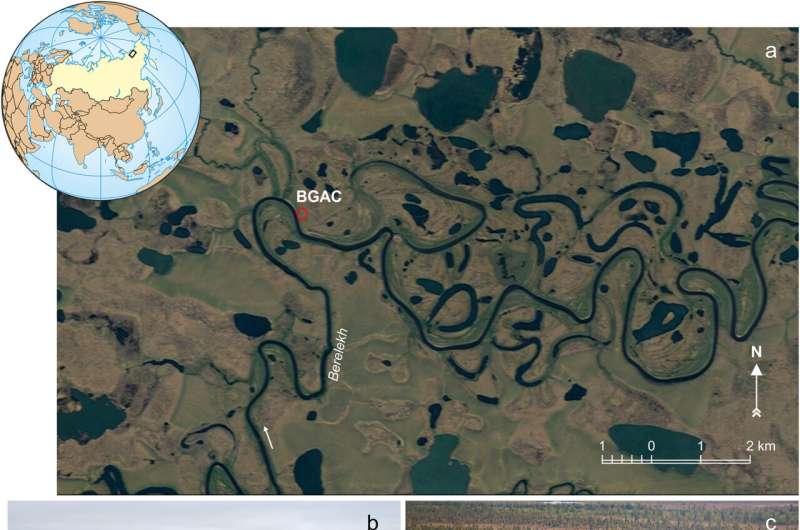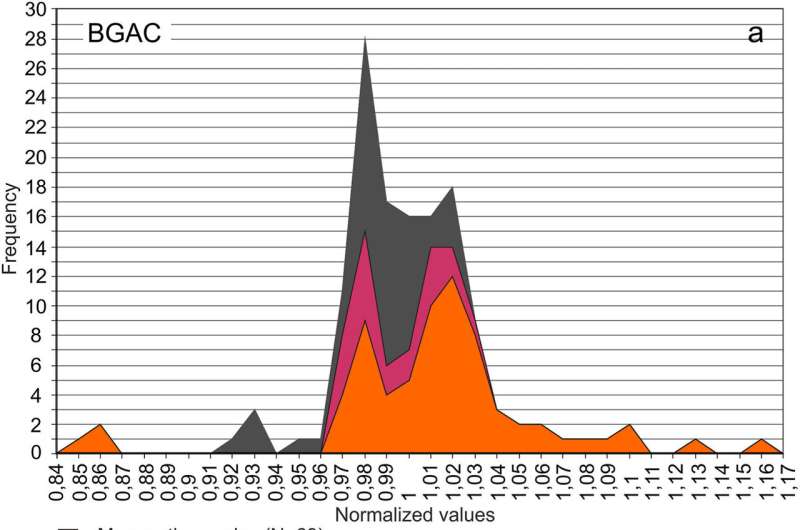June 10, 2024 feature
This article has been reviewed according to Science X's editorial process and policies. Editors have highlighted the following attributes while ensuring the content's credibility:
fact-checked
peer-reviewed publication
trusted source
proofread
Siberia's 'mammoth graveyard' reveals 800-year human interactions with woolly beasts

Woolly mammoths are evocative of a bygone era, when Earth was gripped within an Ice Age. Current knowledge places early mammoth ancestors in the Pliocene (2.58–5.33 million years ago, Ma) before their populations expanded in the Pleistocene (2.58 Ma–11,700 years ago, kyr). However, as climate changed, their numbers dwindled to isolated populations in modern Siberia and Alaska, until their last dated survival 4 kyr ago.
In the East Siberian Arctic (>70 °N), there is not only evidence of significant woolly mammoth populations, but also how humans interacted with them, the focus of new research in Quaternary Science Reviews.
Along the Berelekh River, Russia, a 'mammoth graveyard' can be found. Here, thousands of disarticulated bones, representing a minimum of 156 individual mammoths, found alongside an archaeological site indicate the close proximity of these two communities, forming the Berelekh geoarchaeological complex.
Dr. Vladimir Pitulko, of the Russian Academy of Sciences, and colleagues aimed to assess the relationship between the 'mammoth graveyard' and the archaeological site through a re-examination of stratigraphic and paleogeographic data obtained in 2009, with new fieldwork focused on the left riverbanks where mammoth bones have readily yielded from their home in the sediment and appeared on the water's edge. Alongside them are remains of Pleistocene hare, Arctic fox and wolves, as well as soot and charcoal from hearths and worked mammoth tusks (one being an unfinished throwing spear).
The researchers suggest humans created these bone accumulations as a byproduct of the production of mammoth ivory technology, while hares may have been targeted for fur to produce winter clothing.
Notably, evidence of blowfly pupae activity on cavities in skulls and bones is indicative that the mammoth carcasses were added to the 'graveyard' de-fleshed. Indeed, there appears to be evidence of sorting of the bones, with only the most valuable transported to Berelekh from the area in which the mammoth was killed, leaving behind parts such as spinal columns, carpal ('hand') and tarsal ('foot') bones.

There are three radiocarbon dated peaks in woolly mammoth accumulation at 11.8, 12.2 and 12.4 kyr ago, which fall within known human settlement of the area (11.2–12.4 kyr ago) during the Bølling-Allerød deglacial, when the northern hemisphere warmed and pollen evidence suggests the region became more arid.
Fluctuations in the abundance of mammoths in the 'graveyard' suggest human settlement of the area may also have changed through time (frequent occupation but not permanent), which the researchers attribute to environmental changes on the floodplain permitting suitability for erecting campsites.
Radiocarbon dating of mammoth remains identifies their presence here pre-dating human settlement (beginning ~12.5 kyr ago), but also shows that humans remained in the area (until ~11.2 kyr ago) after mass mammoth remains accumulation declined (~11.8 kyr ago).
Given this, four possible causes are suggested by the scientists to explain such a significant mass accumulation of bones: 1) mass death by natural causes or human, 2) repeated group deaths in the same location, likely due to human predation, 3) concentration of remains by geological processes, such as river action, or 4) solely derived from human predation or scavenging from deceased carcasses.
However, the latter is considered to be the most likely to produce useful tools from ivory tusks, as well as meat to feed the community, as there is no evidence on the bones for a cause of mass death, radiocarbon ages do not cluster into multiple phases for recurrent death deposits and stream flows were unlikely to reach sufficient velocities to transport such heavy bones.
These findings are concurrent with mammoth remains at the Yana Paleolithic site, also in Siberia. Here, estimates suggest the 'graveyard' increased by 1–2 mammoths per year rather than a mass death event, a figure Dr. Pitulko and colleagues conclude could be similar or even higher for Berelekh.
This research is significant as it alters the previously-held belief that there was a lag of 50–80 years between mammoth bone accumulation from natural processes (such as deposition in flood channels) and human settlement, instead now defining a close relationship between the two over 700–800 years. Sadly, now that human-mammoth relationship has continued as ivory hunters have looted the site beyond further study.
More information: Vladimir V. Pitulko et al, From the Berelekh 'mammoth graveyard' to Berelekh geo-archaeological complex: Paleoenvironment, site formation processes, and human-mammoth relationships, Quaternary Science Reviews (2024). DOI: 10.1016/j.quascirev.2024.108692
Journal information: Quaternary Science Reviews
© 2024 Science X Network





















